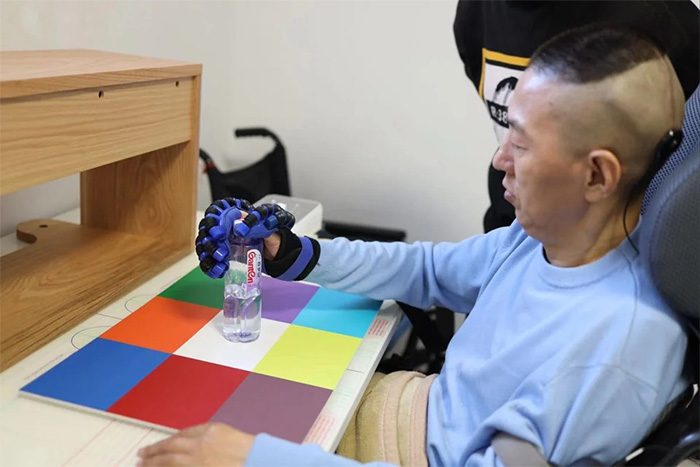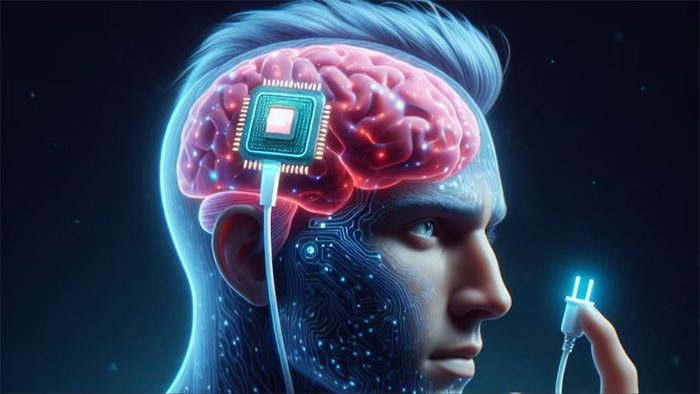Chinese Scientists Develop Wireless Brain-Computer Interface Implant This device has made a breakthrough with its first patient and is less invasive than Elon Musk’s Neuralink chip.
According to the South China Morning Post, Tsinghua University in Beijing recently announced on WeChat that the device developed by their research team has made significant progress in restoring functionality for a patient who was implanted on October 24, 2023.

The first patient to receive the NEO brain chip interface system can grasp objects with the help of a prosthetic hand. (Photo: Handout/Tsinghua University).
Specifically, the implantable device – called Neural Electronic Opportunity (NEO) – has enabled a quadriplegic patient to move their arm with the assistance of a wearable prosthetic device. Scientists state that this device is controlled by the brain and poses no risk of damaging the patient’s nerve cells.
This patient participated in clinical trials registered both domestically and internationally. However, further studies are needed before the device can be approved for clinical use.
Brain-Computer Interfaces (BCIs) are devices that create a direct communication pathway between electrical activity in the brain and external devices, such as computers.
In a press release, Tsinghua University stated that the BCI implant has the potential to assist individuals with severe disabilities in communication and active rehabilitation.
These implantable devices may also benefit patients with spinal cord injuries and even conditions such as epilepsy and amyotrophic lateral sclerosis (ALS).
Tsinghua University noted that the BCI implant could also enable us to combine the intelligence of computers with the brain, enhancing the processing capabilities of the brain.
The minimally invasive implant developed by the Chinese research team is the size of two coins and is designed to be implanted into the human skull. This device does not contain a battery; it is powered remotely using near-field wireless energy and employs high-frequency antennas.

Illustration of brain chip implantation. (Photo: CoPilot).
The NEO system is not implanted directly into the nerve tissue. Instead, the electrodes of this system are placed in the subdural space between the brain and the skull.
The electrodes will capture neural signals and transmit them to an external wireless receiver attached to the scalp. These signals can then be decoded using a phone or computer.
According to Tsinghua University, to ensure the sustainable implantation of the BCI, minimal invasiveness is required.
“Compared to BrainGate, Neuralink, and other types of implanted BCIs, our NEO system has demonstrated a new approach to balance intracranial BCI performance and invasiveness,” Tsinghua University stated.
This week, Elon Musk’s startup Neuralink announced that it has performed the first brain chip implantation in humans, with promising initial results. The goal of this device is to help patients control computers solely with their minds.
Neuralink’s implant differs from the NEO system in that it includes ultra-thin threads implanted in brain tissue. Although designed to penetrate more than 2 mm into the brain, it still goes deeper than some other systems currently in development.
The NEO system has undergone clinical trials in pigs. Tsinghua University reported that the electrodes can achieve “long-term stable recordings” of neural signals while preserving the cortical nerve cells. These neurons in the outer layer of the brain are responsible for essential functions such as memory and learning.
In early 2023, after 10 years of developing the implant, this research group received permission to conduct their first human study.
The first patient implanted with the NEO system has been quadriplegic for 14 years, following a spinal cord injury from a car accident. Within just three months of home rehabilitation, he was able to hold a bottle using a prosthetic hand.
“With the assistance of machine learning algorithms, the patient was able to eat independently,” said Tsinghua University, adding that with recovery and more advanced algorithms, the patient would be able to regain more movement and functionality of the arm.
In December 2023, the Tsinghua University research team, along with medical collaborators at Xuanwu Hospital and Tiantan Hospital in Beijing, also implanted the NEO device into a second patient, who is currently undergoing rehabilitation.
“The next phase of research is to develop a new process for active rehabilitation supported by BCI to promote neural development at the sites of damaged spinal segments,” the scientists stated.





















































